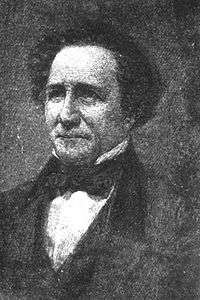Houqua (clipper)
Houqua was an early clipper ship with an innovative hull design, built for A.A. Low & Brother in 1844. She sailed in the China trade.
 Houqua c. 1850 | |
| History | |
|---|---|
| Name: | Houqua |
| Owner: | A.A. Low & Brother |
| Builder: | Brown & Bell, New York City |
| Launched: | 1844 |
| Fate: | Disappeared, 1864 |
| General characteristics | |
| Class and type: | Clipper |
| Tons burthen: | 581 tons, OM |
| Sail plan: | Re-rigged as barque, 1857[1] |
Name
Houqua or named "in honor of the beloved Canton Hong merchant Houqua, who had died the year before, and with whom the Low brothers had traded with in China for many years".[2]
Houqua, (also spelled Howqua or Hoqua), was the most prominent Hong merchant of the day. He "was to take her delivery in China as a warship on behalf of the Chinese government. However, upon arrival, she was found to be too small, and so she spent her career in merchant service for A.A. Low.[1]
Construction

The Houqua design combined the practical experience of an experienced sea captain with the mathematical insights of a leading naval architect of the time, John W. Griffiths.
In 1843, the A. A. Low & Bros. representative in Canton, William Low, and his pregnant wife Ann had been passengers on a very slow and frustrating trip home from Canton with Captain Nathaniel Palmer on Paul Jones. "To vent his frustration [Captain Nat] began carving a block of wood into the shape of what he thought the ideal hull of a Canton trader should look like, one that .. 'would outsail anything afloat' ... "He incorporated John W. Griffiths' ideas concerning a sharp concave bow with his own ideas of a fuller flat-bottomed hull."[2]
Upon arrival in New York, they approached A. A. Low & Bros. with the new design, which was further developed and built by David Brown of Brown & Bell shipyard. Captain Nathaniel Palmer "became an advisor to the Lows as a marine superintendent."
Collision and meteor strike
In 1853, the ferry Tonawanda collided with Houqua in the fog in New York Harbor, necessitating repairs before she could set sail for San Francisco.
"Subsequently, off the Horn, on this passage, she had very heavy weather, lying to, off and on, for many days. On May 5th, in a violent squall, a meteor, apparently about the size of a man’s head, broke at the masthead, throwing out the most violent sparks. Coming down the mast it passed to leeward and the two men standing near were sensibly affected and much frightened."[1]
Disappearance
"She sailed from Yokohama, August 15, 1864, for New York, and was thereafter never heard from again. It is assumed she foundered in a tsunami."[1]
References
- Howe, Octavius T; Matthews, Frederick C. (1986) [Reprint of 1926-1927 ed.]. American Clipper Ships 1833-1858. Volume 1, Adelaide-Lotus. New York: Dover Publications. ISBN 978-0486251158.
- Ross, Don. "The Era of the Clipper Ships". China Tea Trade. The Era of the Clipper Ships. Retrieved May 9, 2010.
External links
- Logbook of a seasick ‘‘Hoqua’’ passenger bound for Canton, 1846
- Hoqua and the China Tea Trade, The Era of the Clipper Ships
Further reading
- Low, Charles Porter (1905). Some recollections by Captain Charles P. Low, commanding the clipper ships Houqua, Jacob Bell, Samuel Russell, and N.B. Palmer in the China trade, 1847-1873. Boston: Geo. H. Ellis Co.
clipper ship.